As 5G becomes more commercialized, the industry is keen to start discussing 6G, making it a hot topic in recent years. This is especially the case with the outbreak of the Russo-Ukrainian war, as low-orbit satellites have strengthened the resilience of basic communications in different countries and brought various possibilities for 6G in terms of wireless network coverage and stability. Therefore, on October 27 this year, Auden held the SmartLife for Next Generation Seminar: Toward 6G Era - Bridging Key Innovative Technologies, inviting experts from the industry, government, and academia to conduct comprehensive and extensive discussions on the millimeter wave, Open Radio Access Network (ORAN), and biomedicine.

From left to right: Dr. Li-Fung Chang (President of Atayalan Taiwan), Professor Ruey-Beei Wu (Convener of the Taiwan Electromagnetic Industry-Academia Consortium), Ms. Pei-Ti Hu (Deputy Director-General of the Administration for Digital Industries, MODA), Mr. Yu-Pin Chang (Chairman of Auden Techno Corp.) and Professor Tzong-Lin Wu (National Taiwan University).
Photo: Auden Techno
In the post-pandemic era, domestic industries, government, and academia gather to explore 6G technology
During his welcome speech, Mr. Yu-Pin Chang, Chairman of Auden Techno Corp., indicated that this was the 6th SmartLife for Next Generation Seminar. Due to the pandemic in the past two years, the event had to be suspended in 2021. Although the pandemic has improved this year, it was still difficult for many foreign scholars to join the event because of the epidemic prevention policies and other factors. For the discussion topics of the seminar this year, from 5G to 6G, information security to private networks, and low-orbit satellites, these issues are all interconnected, and they play vital roles in future technological developments. The agenda for this event was also quite extensive, with many major technological developments and research being discussed. Mr. Chang believes the event would enhance Taiwan's development prospects immensely, ranging from technology to application.
During her speech, Ms. Pei-Ti Hu, Deputy Director General of the Administration for Digital Industries, MODA, anticipated that applications for 5G private networks would begin next year. With the launch of 5G private networks, smart manufacturing, smart healthcare, and smart transportation would undergo further enhancement. In other words, Ms. Hu's anticipation also echoed the aforementioned views, whereby social development and social inclusion would have more room for development. When private networks are launched, the development of next-generation communication technologies has to be considered. This is also why the seminar has a special significance.
Dr. Pei-Zen Chang, Executive Vice President of the Industrial Technology Research Institute, commended Auden who has been a collaborative partner of ITRI for many years. Dr. Chang is currently responsible for overseeing three departments of the ITRI, namely optoelectronics, information and communications, and biomedicine, which are three areas closely linked to the agenda of the seminar. Dr. Chang also talked about 5G-related technological developments. In the past, millimeter wave was generally used in national defense and aerospace. However, in the last five years, it has been gradually utilized in telecommunication base stations. The technological advancement has been truly impressive. Nevertheless, as the world embarks on the 6G era, in addition to millimeter waves, the inclusion of low-orbit satellites and ORAN technology is expected to give rise to much technological complexity. On the other hand, the application of electromagnetic waves in biomedicine should also be considered. Currently, the ITRI is involved in the development of these technologies, and Dr. Chang hopes for deeper cooperation between both parties in the future.
Professor Ruey-Beei Wu, Convener of the Taiwan Electromagnetic Industry-Academia Consortium, pointed out that the three main aspects of 5G are generally known to be "high capacity, low latency, and multiple connections". In the 6G era, there are three additional aspects. The first is full coverage. With the advent of the metaverse, video applications online will change our lives immensely. Meanwhile, the internet service for one-third of the world's population still requires improvement. With the commercialization of 6G, the problem is expected to be alleviated to a certain extent. The second aspect is intelligent automation, such as unmanned vehicles, which include drones and autonomous cars. The last aspect concerns energy conservation and environmental protection. The industry must contemplate how it can respond to ESG issues while implementing 6G technological developments.
5G ORAN will bring the next wave of industry opportunities and Taiwan should seize the key opportunities
Dr. Li-Fung Chang, President of Ataylan Taiwan, indicated that there is an extremely important part of 5G, which is the vertical applications. Broadly speaking, rural area, education, and industrial IoT applications can all be included in the purview of corporate private networks. However, they must first apply for the spectrum. As for ORAN, which has been a popular topic recently, Dr. Chang believes that Taiwan still needs time before it can seize the opportunities of the ORAN market. Currently, the interest of the US market is relatively mild towards ORAN. Nevertheless, in general, it is still focusing on system integration. At present, Auray Technology (a subsidiary of Auden Techno Corp.) is providing authentication and testing services for ORAN, of which Ms. Chang looks forward to these services being utilized in real applications in Taiwan's 5G private networks and the company expanding operations in the global market.
Professor Tzong-Lin Wu, convener of MOST's R&D Program for Key Technologies of the Next Generation Communication System, agreed with Dr. Chang's views, and noted Taiwan used to hold the leading position in hardware manufacturing and design capabilities in the past. As such, ORAN is a relatively important market opportunity for Taiwan. Moreover, 6G will be rather helpful to the development of digital twins. As 6G drives the implementation of ultra-broadband technology, many AR and VR applications discussed in the past will be realized in many application settings.
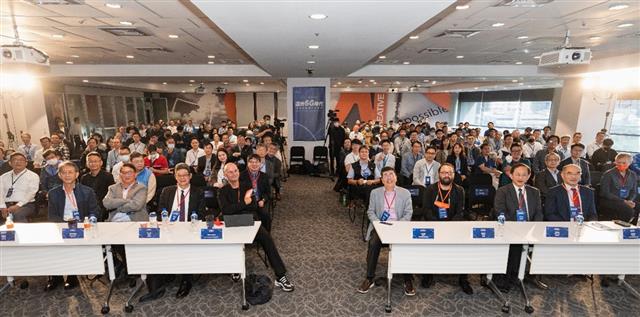
The SmartLife for Next Generation Seminar: Toward 6G Era - Bridging Key Innovative Technologies has gathered experts from the industry, government, and academia.
Photo: Auden Techno
For future developments of 5G, testing requirements will undergo corresponding changes
The keynote speech in the morning session brought forth important information shared by professionals from the industry, government, and academia. Dr. Niels Kuster, Director of IT'IS Foundation and Professor of Eidgenössische Technische Hochschule Zürich (ETH Zürich), gave his speech on the topic, "Compliance Testing of 5G & 6G Devices: New Requirements & Instrumentations", explaining SPEAG's current development of many testing projects for testing equipment (Schmid & Partner Engineering AG (SPEAG) is one of the main strategic members of Zurich43. ETH Zürich is also a member of Zurich43). Dr. Kuster indicated that the testing of SPEAG's solutions under multiple spectrum ranges is expected to be completed in the third to fourth quarter of this year (2022). Under the current planning for 5G FR2 (Frequency Range 2), as opposed to FR1, the frequency will be increased from 7.1GHz to 71GHz. The frequency range of FR2 falls between 24.2GHz and 71GHz. In the future, the bands of 6G frequency range will be divided further into different ranges for the use of different applications.
Furthermore, Dr. Kuster specifically mentioned the IEEE 63195 standard, which was published in May 2022. The standard mainly involves methods for the assessment of power density of human exposure (such as the head and body) to radiofrequency fields (frequency range falls between 6GHz and 300GHz). At the same time, regarding the phase retrieval function of SPEAG's DAYS8 Module solution, he further explained the main differences between plane-to-plane phase reconstruction (PTP-PR) and equivalent source reconstruction (ESR).
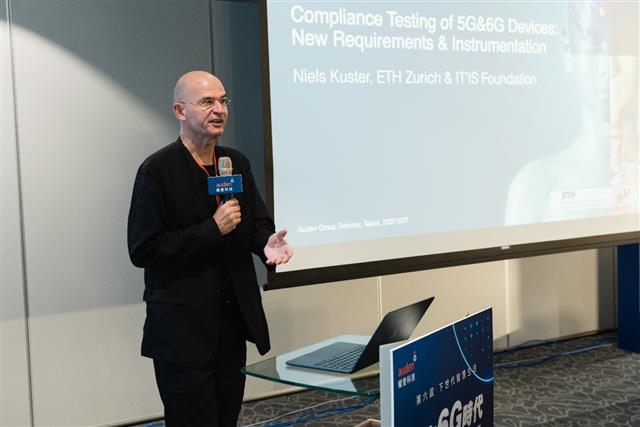
Prof. Dr. Niels Kuster / IT'IS Foundation & ETH Zurich.
Photo: Auden Techno
Qualcomm will build Connect Smart Edge via comprehensive solutions
Mr. Paul Chen, Qualcomm's Senior Director of Product Management, indicated that Qualcomm not only provides chip solutions but also comprehensive system-level solutions. With the help of partners in the ecosystem, Qualcomm is able to satisfy the development needs of customers for various applications. For 5G, in addition to smartphone applications, the more important aspect is the concept of the Internet of Everything (IoE). These "things" can be viewed as smart edge, and Qualcomm offers relatively comprehensive solutions to satisfy the needs in these fields. Mr. Chen also quoted data from research institutions and pointed out that in the future, it is conceivable that the amount of data generated by terminals will be rather astounding. In the 5G era, Qualcomm's terminal devices will be equipped with AI functions and able to improve data transmission stability of the devices. Of course, for AI computing, if CPU processing is used, the computing efficiency will be sub-optimal. However, if a specific neural computing engine is utilized for processing, the efficiency can be improved tremendously. Qualcomm has accumulated extensive technologies and experience in this field, and therefore, it is able to simplify the intellectualization of terminal devices.

Paul Chen / Senior Director, Product Management, Qualcomm.
Photo: Auden Techno
Actual standards for 6G have yet to be determined. Rel.19 should start the formulation process
Dr. Zhong-Yong Jia, Vice President of the Chunghwa Telecom Internet Technology Branch, first reviewed the development of 5G in Taiwan. Currently, Taiwan's 5G telecommunications network is still in the non-standalone (NSA) stage and must rely on support from 4G base stations to provide 5G services. In terms of version, Chunghwa Telecom has only developed the system to half of Rel.15 specifications, and the main definition for Rel.16 is high speed, low latency and multiple connections. In other words, Chunghwa Telecom still has a long way to go to get to Rel.16. The so-called 5G Advance (also known as B5G) is generally deemed to be a version of Rel.18 by the industry. Whereas, Rel.17 is extended from the definition of Rel.16, with content and definition of low-orbit satellites added in. As for 6G, 3GPP has not further formulated the related standards. However, Chunghwa Telecom predicts that the demand for 6G will begin to emerge in the next three years. In other words, the formulation of 6G standards will probably begin with Rel.19. Chunghwa Telecom also predicts that Rel.19 to Rel.22 will be covered by the formulation of 6G standards.
Furthermore, Dr. Jia thinks that the advent of 6G era will occur in the next five to six years. For the division of 6G frequency bands, the low-frequency band will fall between 7 and 20 Ghz, while the high frequencies will fall between 100GHz and 300GHz. The demand for 6G must be driven by consumers. From 5G to 6G, in addition to high speed, low latency, and multiple connections, Chunghwa Telecom hopes to give 6G "full connectivity, ubiquity, and security everywhere", which means that all devices can be connected, everyone can enjoy the services, and the network will have a certain level of security. The networking model for 5G is divided into standalone (SA) and non-standalone (NSA). The industry is still discussing the models for 6G and it requires future observations.
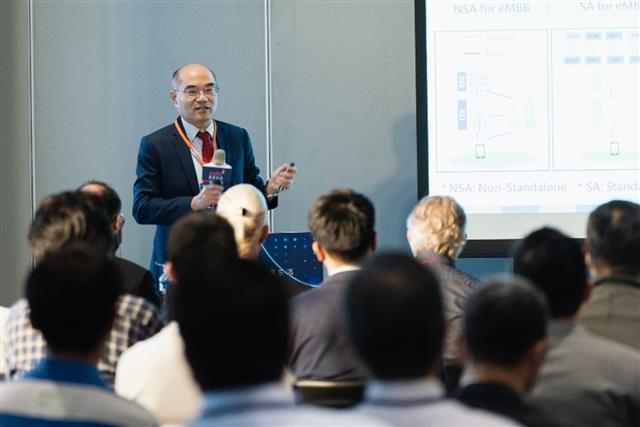
Dr. Zhong-Yong Jia/Vice President of the Chunghwa Telecom Internet Technology Branch.
Photo: Auden Techno
Dr. Ching-Kuang Chuang, Professor Emeritus of National Taiwan University, talked about large-scale antenna arrays and shared the future technological trends of the arrays. Dr. Chuang cited 72 to 78GHz beamformers as an example. The beamformers are 2 x 1 square meter in size and consist of several antenna modules in an array. He indicated that future antenna module composition will be divided into three parts. In this regard, in addition to the lens, he mainly discussed the structuring technology of specular reflection in micro-electromechanical systems (MEMS). Meanwhile, semiconductor products for pure digital and hybrid radio frequency signals are also vital parts of the antenna array.
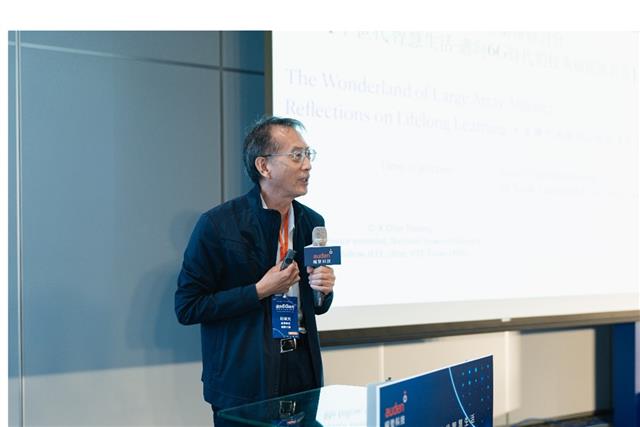
Dr. Ching-Kuang Chuang, Professor Emeritus of National Taiwan University.
Photo: Auden Techno
Dr. Yongxin Guo, Professor of National University of Singapore, gave his speech on "Efficient Wireless Power Transfer for IoTs and Biomedical Applications" remotely. He explored the related technological developments and shared the development trends of energy harvesting in IoT nodes. For example, when the transmitter is 1.5 meters away from the receiver, the receiver can finish charging within 35 minutes. The second half of his speech focused on the information and communications technologies (ICT) derived from smart healthcare.
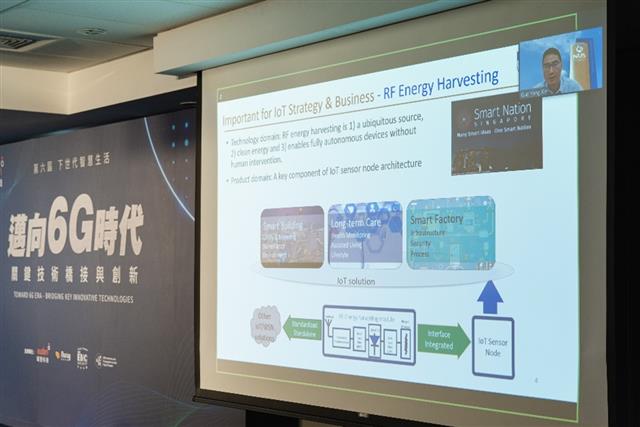
Prof. Dr. Yongxin Guo / National University of Singapore.
Photo: Auden Techno
For the seminar agenda of Auden Techno Corp., important guests from the industry, government, and academia were invited to share industry and technology trends in the morning sessions. There were three tracks in the afternoon session. Track A focused on B5G to 6G technologies and covered large-scale antenna hybrid beamforming and millimeter wave measurement technologies. The session was chaired by Professor Peter Hong of National Tsing Hua University. Professor Dah-Chung Chang (National Central University), Mr. Chih-Yuan Chu (CEO of Ohmplus Technology Inc.), Mr. Wei-Hsiang Yang (Manager of Auden Techno Corp.), Mr. Run-Kai SHiu (Senior Development Engineer of Auden Techno Corp.), and Yung-Tai Hsu (Manager of Auden Techno Corp.) delivered speeches. Track B explored smart healthcare, such as physiological signal analysis and precision records of electrocardiogram (ECG) and photoplethysmogram (PPG), and applications for neurosurgery. Other interesting case studies were also shared. The session was chaired by Professor You-Yin Chen of National Yang Ming Chiao Tung University. The invited speakers were Dr. Erdem Ofli and Dr. Nicolas Chavannes (Zurich Med Tech), Dr. Yu-Chi Wang and Dr. Chien-Hung Liao (Chang Gung Memorial Hospital), and Mr. Wei-Kai Ting (Chief Technology Officer of WhaleTeq Co., Ltd.) Track C includes a series of discussions on ORAN, covering issues related to information security and 5G private networks. The session was chaired by Professor Hsi-Tseng Chou of National Taiwan University. The invited speakers were Professor Ray-Guang Cheng (National Taiwan University of Science and Technology), Ms. Pi-Chen Chiu (Deputy Supervisor of the Industrial Technology Research Institute), and Mr. Chih-Ming Tsai and Dr. Chun-Chi Su (Assistant Vice Presidents of Auray Technology Corp).
The development of millimeter wave 5G, satellite communications, and more next-generation communication technologies is leading global communication towards a new 6G world. The seminar held by Auden Techno Corp. this year has brought key technologies and new perspectives for embarking on the 6G era. By continuously holding the annual seminars, Auden seeks to put in more effort to analyze the latest industry and market trends, as well as technological development trends to welcome the smart life for the next generation!

The 6th SmartLife for Next Generation Seminar: Toward 6G Era - Bridging Key Innovative Technologies has been a success. Hope to see you again next year!
Photo: Auden Techno